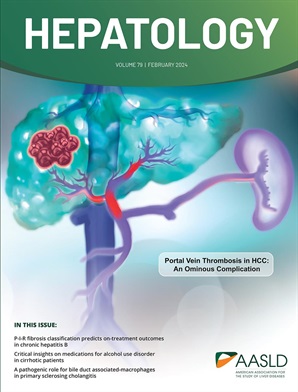Altered blood-brain barrier permeability is associated with abnormal distant connectivity and regional homogeneity in covert hepatic encephalopathy - a cross sectional study.
IF 12.9
1区 医学
Q1 GASTROENTEROLOGY & HEPATOLOGY
引用次数: 0
Abstract
BACKGROUND Covert hepatic encephalopathy (CHE) is clinically underrecognized. Using MRI, we explored the relationship between functional connectivity as a marker of executive dysfunction and the blood-brain barrier permeability marker KTRANS in a cross-sectional cohort of covert HE (CHE), no HE (NHE), and healthy controls (HC). METHODS This study was a single-center prospective cohort study conducted between 2018 and 2021. CHE was diagnosed using the Psychometric Hepatic Encephalopathy Score (PHES) with an abnormality threshold of <-4. Blood brain barrier permeability was determined using MRI KTRANS, based on cerebral efflux of gadolinium from blood plasma to the extravascular space. Resting-state fMRI determined the intrinsic dynamics of regions of the brain. RESULTS Three cohorts were recruited: cirrhosis and CHE (n=17); cirrhosis with no HE (NHE; n=13); and healthy controls (n=10). There was a significant negative correlation (r=-0.59, p=0.003) between KTRANS and components of the Default Mode Network (DMN). Group-level ANOVA (F-test) revealed a significant difference between groups in functional connectivity within the Salience Network (SN) (Cluster level significance, F(4,62)=8.45, pcorrected=0.000005) and the DMN (Cluster level significance, F(4,62)=6.20, pcorrected=0.0004). The analysis revealed significant differences in regional homogeneity between the CHE and Health Controls. CONCLUSION There was a strong association between disrupted blood-brain barrier (BBB) integrity and attenuated functional connectivity, with reductions in functional connectivity within the DMN and Frontoparietal Network (FPN), circuits closely linked to executive control. This attenuation was evident both in local regional and in distant connectivity within these networks.隐匿性肝性脑病的血脑屏障通透性改变与异常的远端连通性和区域均匀性有关——一项横断面研究。
背景:隐匿性肝性脑病(CHE)在临床上未被充分认识。利用MRI,我们在隐匿HE (CHE)、非HE (NHE)和健康对照(HC)的横断面队列中探讨了功能连通性作为执行功能障碍的标志物与血脑屏障通透性标志物KTRANS之间的关系。方法本研究为2018 - 2021年开展的单中心前瞻性队列研究。CHE的诊断采用肝性脑病心理测量评分(PHES),异常阈值<-4。基于钆从血浆向血管外空间的脑外排,采用MRI KTRANS测定血脑屏障通透性。静息状态fMRI确定了大脑各区域的内在动态。结果纳入三个队列:肝硬化和CHE (n=17);肝硬化无HE (NHE;n = 13);健康对照组(n=10)。KTRANS与Default Mode Network (DMN)各组成部分呈显著负相关(r=-0.59, p=0.003)。组水平方差分析(F检验)显示,组间显著性网络(SN)内的功能连通性(聚类水平显著性,F(4,62)=8.45, pcorrected=0.000005)和DMN(聚类水平显著性,F(4,62)=6.20, pcorrected=0.0004)存在显著性差异。分析显示,卫生和社会福利计划和卫生控制计划在区域同质性方面存在显著差异。结论血脑屏障(BBB)完整性破坏与功能连通性减弱之间存在强烈关联,与执行控制密切相关的DMN和额顶叶网络(FPN)的功能连通性降低。这种衰减在这些网络的本地区域和远程连接中都很明显。
本文章由计算机程序翻译,如有差异,请以英文原文为准。
求助全文
约1分钟内获得全文
求助全文
来源期刊

Hepatology
医学-胃肠肝病学
CiteScore
27.50
自引率
3.70%
发文量
609
审稿时长
1 months
期刊介绍:
HEPATOLOGY is recognized as the leading publication in the field of liver disease. It features original, peer-reviewed articles covering various aspects of liver structure, function, and disease. The journal's distinguished Editorial Board carefully selects the best articles each month, focusing on topics including immunology, chronic hepatitis, viral hepatitis, cirrhosis, genetic and metabolic liver diseases, liver cancer, and drug metabolism.
 求助内容:
求助内容: 应助结果提醒方式:
应助结果提醒方式:


